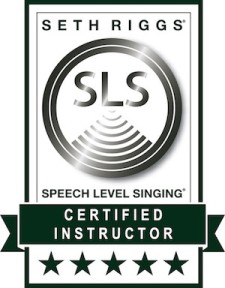Speech Level Singing
are an inspiration to me. I hope I can do for my students what you have done for me!”

Izabela Adams with Maestro Seth Riggs
SLS International Teachers Conference
Valley Park, UT, 2012
What is Speech Level Singing? (SLS)
Speech Level Singing ™, “The Technique of Legends” was created by Hollywood vocal coach, Seth Riggs. For over 50 years, Seth Riggs and his Speech Level Singing method has assisted over 130 Grammy winners and many Broadway and Academy Award winning stars. Speech Level Singing (SLS) is a revolutionary vocal training technique that maximizes your vocal abilities no matter what style of singing you call your own. Speech Level Singing is a way of using your voice that allows you to sing freely and clearly with maximum power and clarity. Since you are not learning what to sing but rather how to sing and maintain an even balance through your bridges (see ‘The SLS Method’ below for more information on bridges), you can apply this technique to any type of music.
Who’s Seth Riggs?
Seth Riggs is considered by many to be the best and most successful voice teacher in the world. He is certainly the busiest. No other teacher, past or present, has ever matched his phenomenal track record. His students are a veritable “Who’s Who” of singers, actors, dancers, and entertainers throughout the world, such as: Stevie Wonder, Natalie Cole, Anita Baker, Julio Iglesias, Adam Lambert, Ricky Martin, Whoopi Goldberg, Prince, Josh Groban (First Album Only), Ray Charles, Barbara Streisand, Kevin Kline, Michael Jackson, Cher, Tina Turner, Diana Ross, Jeremy Irons, Kirsten Dunst, Janet Jackson, Madonna, Samuel L. Jackson, Bernie Mac, Jennifer Lopez, Bette Midler, Liza Minelli, Cher, Conan O’Brien, and the list goes on…
The SLS Method
Speech Level Singing is a technique based on the recognition and use of the “bridges” or “passaggi” in the voice. The bridges are the area of the voice where vocal cord adjustment must take place in order to sing both the high and low range. The SLS technique frees the vocalist to sing with a connected tone from the bottom of their range to the top by keeping the larynx down and the vocal cords together appropriately. Traditional vocal methods often only address using the bottom of the range (chest voice) for pop/theater styles or just using the top of the range (head voice) for classical styles which limits a singer in their capacity to sing throughout their range with a connected, uniform voice. The key to SLS is in understanding the bridges and learning to mix. Not using the voice properly throughout the whole range can lead to strain, incorrect pitch, vocal fatigue, and vocal damage.
SLS was created for you to sing with the same comfortable, easily-produced voice you use when you speak. No matter where the notes are in your vocal range, SLS helps to develop balance and strength in the voice.
“What most teachers don’t understand is that you don’t need to think about twenty different things every time you open your mouth. And you don’t need to study singing for more than a few weeks before you begin to experience positive results…It doesn’t matter whether you sing Pop, Rock, Opera, or Musical Theater. You should sing with a technique that allows you to just relax and concentrate on performing- which is what it’s all about anyway, right?” – Seth Riggs
How it works?
Basically, if the larynx stays down and the vocal cords stay together from the very bottom of the vocal range to the very top, everything is fine. This also applies to all vowel and consonant combinations throughout any phrase. If at any point the larynx jumps up or down or the tone becomes breathy, then there is something wrong with the vocal process.
The larynx is the big bump in the middle of the neck just below the chin. This houses the vocal cords and controls the process of swallowing. When the larynx moves up, the muscles around the cords act as a sphincter and close so as to prevent swallowing down the windpipe and into the lungs. This is a very important process when you need to swallow, but it is a very poor process when you are trying to sing. If you place your hand on your larynx and yawn, you will find that you can bring your larynx down. This is a good way to learn what it feels like to have the larynx stay down. The end goal here is to be able to keep the larynx from moving down as well as up. It should stay completely still as you ascend and descend.
The vocal cords, also known as the vocal folds, are a pair of soft tissue cords that are joined at the front of the larynx and extend back. When they close, the back end of the cords come together (adduct), and the flow of air is temporarily stopped. When the pressure of air from the diaphragm overpowers the pressure of the muscles holding the cords together, they are blown apart and sound is made when they close again due to the resonation created. Then, once again, the air pressure overpowers the muscle pressure and the process begins again.
If the vocal cords begin to come apart, the tone becomes breathy and the muscles around the outside of the larynx begin to tense. This becomes what is called a constricted phonation and is quite harmful for the voice.
This is a very brief and condensed version of what happens when you sing, during your SLS lessons these concepts & techniques are fully explored.



